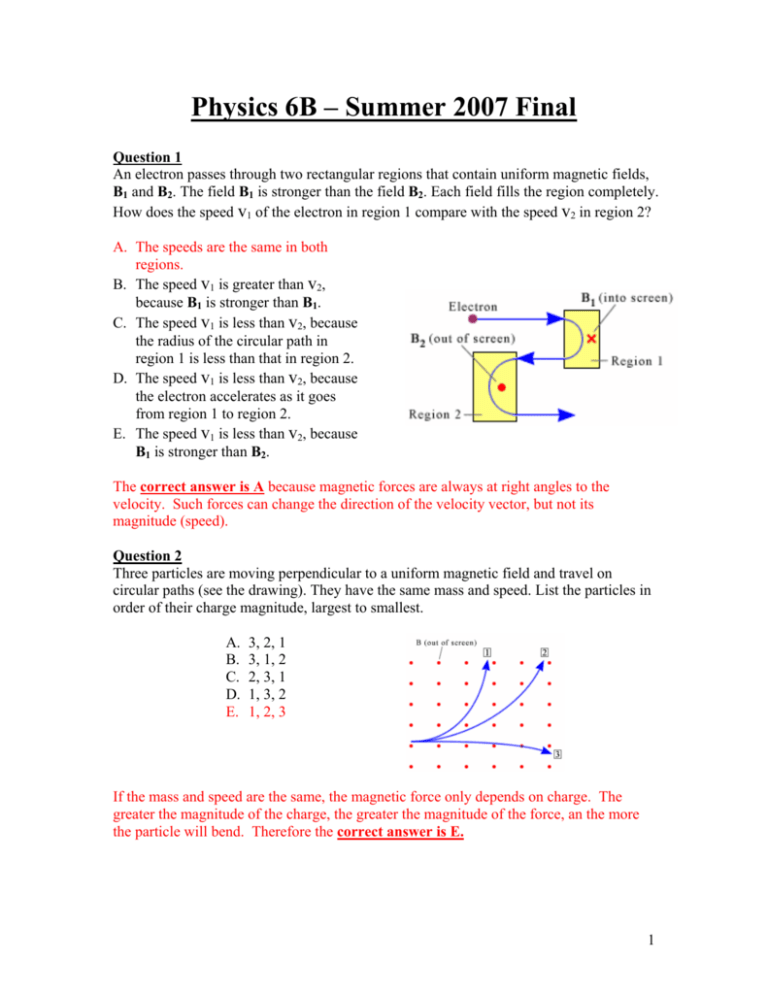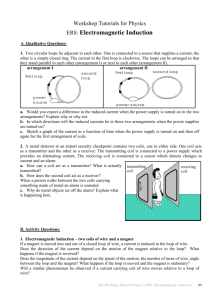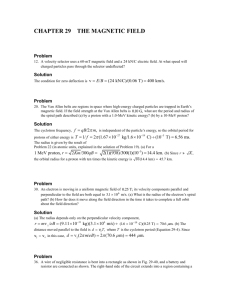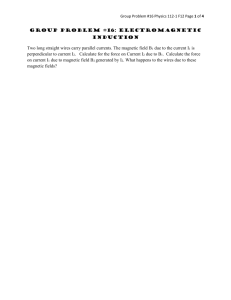here - UCSB HEP
advertisement

Physics 6B – Summer 2007 Final Question 1 An electron passes through two rectangular regions that contain uniform magnetic fields, B1 and B2. The field B1 is stronger than the field B2. Each field fills the region completely. How does the speed v1 of the electron in region 1 compare with the speed v2 in region 2? B B B B A. The speeds are the same in both regions. B. The speed v1 is greater than v2, because B1 is stronger than B1. C. The speed v1 is less than v2, because the radius of the circular path in region 1 is less than that in region 2. D. The speed v1 is less than v2, because the electron accelerates as it goes from region 1 to region 2. E. The speed v1 is less than v2, because B1 is stronger than B2. B B B B The correct answer is A because magnetic forces are always at right angles to the velocity. Such forces can change the direction of the velocity vector, but not its magnitude (speed). Question 2 Three particles are moving perpendicular to a uniform magnetic field and travel on circular paths (see the drawing). They have the same mass and speed. List the particles in order of their charge magnitude, largest to smallest. A. B. C. D. E. 3, 2, 1 3, 1, 2 2, 3, 1 1, 3, 2 1, 2, 3 If the mass and speed are the same, the magnetic force only depends on charge. The greater the magnitude of the charge, the greater the magnitude of the force, an the more the particle will bend. Therefore the correct answer is E. 1 Question 3 Suppose you want to produce a strong magnetic field that is constant in magnitude and direction in a region of space. Which one of the following would you choose to produce this field? A. The interior region of a long current-carrying solenoid. B. The exterior region of a long current-carrying solenoid. C. The region surrounding a long, straight, current-carrying wire D. The region surrounding a loop of a current-carrying wire. The only configuration that gives an (approximately) constant B-field is A. Question 4 Three long, straight wires are carrying currents that have the same magnitude. In C the current is opposite to that in A and B. The wires are equally spaced. Each wire experiences a net force due to the other two wires. Which wire experiences a net force that has the greatest magnitude? A. A B. B C. C D. All three wires feel the same force On wire B the forces due to A and C act in the same direction and so reinforce each other. On the other hand, on wires A and C the forces (due to B and C and A and B respectively) act in opposite directions and therefore tend to cancel out. Correct answer is B. Question 5 The drawing shows four situations in which two very long wires are carrying the samecurrent, although the direction of the currents may be different. The point P in the drawings is equidistant from each wire. Which one (or more) of these situations gives rise to a zero net magnetic field at P? A. 2 and 4 B. Only 1 C. Only 2 D. 2 and 3 E. 3 and 4 1: the two fields add (both into the paper) 2: the two fields cancel (one into the paper, one out of the paper) 3: field from vertical wire into the paper, field from horizontal wire also into the paper 4: field from vertical wire out of the paper, field from horizontal wire into the paper Æ correct answer is A 2 Question 6 Two different charges, q1 and q2, are placed at two different locations, one charge at each location. The locations have the same electric potential V. Do the charges have the same electric potential energy? A. Yes. If the electric potentials at the two locations are the same, the electric potential energies are also the same, regardless of the type (+ or -) and magnitude of the charges placed at these locations. B. Yes, because electric potential and electric potential energy are just different names for the same concept. C. No, because the electric potential V at a given location depends on the charge placed at that location, whereas the electric potential energy does not. D. No, because the electric potential energy at a given location depends on the charge placed at that location as well as the electric potential V. U1=q1V and U2=q2V Æ correct answer is D Question 7 A proton is released from rest at point A in a constant electric field and accelerates to point B (see part a of the drawing). An electron is released from rest at point B and accelerates to point A (see part b of the drawing). The distances traveled by the proton and the electron are the same. How does the change in the proton's electric potential energy compare with the change in the electron's electric potential energy? A. The change in the proton's electric potential energy is the same as the change in the electron's electric potential energy. B. The proton experiences a greater change in electric potential energy, since it has a greater charge magnitude. C. The proton experiences a smaller change in electric potential energy, since it has a smaller charge magnitude. D. The proton experiences a smaller change in electric potential energy, since it has a smaller speed at B than the electron has at A. This is due to the larger mass of the proton. E. One cannot compare the change in potential energies because the proton and electron move in opposite directions. For proton, charge +e: For electron, charge –e:: Æ correct answer is A ΔU = UB – UA = (+e)VB - (+e) VA = e(VB - VA ) ΔU = UA – UB = (-e)VA - (-e) VB = e(VB - VA ) 3 Question 8 Two identical resistors are connected first in series and second in parallel. The equivalent resistances of the two types of connections are, respectively, RS and RP. What is the ratio RS/RP? A. ¼ B. 4 C. ½ D. 1 E. 2 RS = 2R while RP=½R Æ correct answer is B Question 9 The following four equations are supposed to result from applying Kirchhoff's rule to the circuit shown in the drawing. However, one of the equations is written incorrectly. Which one is it? A. I1 = I4 + I5 B. I3 = I1 + I2 C. I6 = I3 + I5 D. I2 = I4 + I6 Kirchoff at node A: I4 + I5 = I1 Kirchoff at node B: I1 + I3 = I2 Kirchoff at node C: I3 + I5 = I6 Kirchoff at node D: I4 + I6 = I2 Æ correct answer is B 4 Question 10 The drawings show a number of different possibilities for connecting an ammeter (AM) and a voltmeter (VM) to a circuit, in order to measure the current in and the voltage across the resistor labeled R2. Which one of the possibilities shows the correct connections? A. D.: B. C. E. Correct answer is A because VM must be placed in parallel with R2 and AM must be placed in series with R2. Question 11 Three capacitors are identical, each having a capacitance C. Two of them are connected in series. Then, this series combination is connected in parallel with the third capacitor. What is the equivalent capacitance of the entire connection? A. ½ C B. 1/3 C C. 3 C D. 2/3 C E. 3/2 C The series combination has capacitance Ceff = ½C. Then we have Ceff in parallel with C, for a total capacitance Ceff = C = ½C + C = 3/2 C Æ correct answer is E Question 12 A magnetic field is perpendicular to the plane of a flat coil. Since the magnitude of the field is increasing, an emf will be induced in the coil unless something is done to prevent it. Except for one option, all of the following are possible options that could be used to keep the emf at the zero level. Which option could not be used? 5 A. Decrease the area of the coil. B. Increase the angle between the field and the normal to the plane of the coil. C. Simultaneously decrease the area of the coil and increase the angle between the field and the normal to the plane of the coil. D. Reduce the time interval during which the magnitude of the field increases. D does not work because emf = Δφ/Δt Æ correct answer is D Question 13 A long, vertical, straight wire carries a current I. The wire is perpendicular to the plane of a circular metal loop and passes through the center of the loop (see the drawing). The loop is allowed to fall and maintains its orientation with respect to the straight wire while doing so. In what direction does the current induced in the loop flow? A. There is no induced current. B. Around the loop from A to B to C to A C. Around the loop from C to B to A to C As the loop falls, the flux does not change Æ no induced current Æ correct answer is A Question 14 The drawing shows a top view of two circular coils of conducting wire lying on a flat surface. The centers of the coils coincide. In the larger coil there is a switch and a battery. The smaller coil contains no switch and no battery. Describe the induced current that appears in the smaller coil when the switch in the larger coil is closed. A. It flows counterclockwise forever after the switch is closed. B. It flows clockwise forever after the switch is closed. C. It flows counterclockwise, but only for a short period just after the switch is closed. D. It flows clockwise, but only for a short period just after the switch is closed. Current in large coil flows counterclockwise Æ by Lenz’s law current in small coil must flow anticlockwise. But only for a small time, because once the current in the outer coil becomes constant, the emf in the smaller coil goes away Æ correct answer is D 6 Question 15 A point charge q is located at the origin. A charge q0 can be placed at a point P1, which is a distance r from the origin (top drawing). Or, a charge 2q0 can be placed at P2, which is a distance 2r from the origin (bottom drawing). All charges are positive. Which statement is true about the electric potentials at P1 and P2? A. The electric potential at P1 is less than that at P2, because q0 is smaller than 2q0. B. The electric potential at P1 is less than that at P2, because r is smaller than 2r. C. The electric potential at P1 is greater than that at P2, because r is smaller than 2r. D. The electric potential at P1 is the same as that at P2. V(P1)=kq/r and V(P2)=kq/(2r) Æ correct answer is C Question 16 Five volts is applied to two 2 ohm resistors in series. The resulting current is A. 5A B. 2.5 A C. 1.25 A D. 0.8 A E. 0.4 A Req = 2R = 4Ω. I=V/Req = (5/4) A = 1.25 A Æ correct answer is C Question 17 What is the charge on the 30μF capacitor in the Figure? A. B. C. D. 40 C 0.00054 C 1389 C 0.00018 C The voltage across C3 is V=18V Æ Q=CV=30 10-6 18 C = 0.00054 C Æ correct answer is B 7 Question 18 Mutual induction leads to an induced emf εs in a secondary coil when a change ΔIP in the current in the primary coil occurs in a time Δt. The mutual inductance between the coils is M. The relative positions of the coils is then changed, after which a change of 2 ΔIP in the primary current in a time of ½ Δt is needed to produce the same induced emf εs in the secondary coil. What is the mutual inductance with the coils in their new positions? A. ¼ M B. ½ M C. M D. 2 M E. 4 M ε = Μ ΔI/Δt and ε = Μnew (2ΔI)/(½ Δt) = 4 Μnew ΔI/Δt Æ Μnew = ¼ M Æ correct answer is A Question 19 Inductor 1 stores the same amount of energy as inductor 2, although its inductance is only half the inductance of inductor 2. What is the ratio I1/I2 of the currents in the two inductors? A. 2.00 B. 1.41 C. 4.00 D. 0.50 E. 0.25 U = ½ L1I12 and U = ½ (2L1) I22 Æ I12 = 2 I22 Æ I1 / I2 = 1.41 Æ correct answer is B Question 20 Lines of magnetic field are A. Always straight lines B. Terminate on negative charges C. Point in the direction of the magnetic force exerted on a positive charge D. Are always perpendicular to the equipotentials E. Point in the direction of the magnetic field Correct answer is E 8 Question 21 In an ionic solution, positive sodium ions (Na+) are moving to the right and negative chlorine ions (Cl-) are moving to the left. In which direction is the current due to the motion of (i) the sodium ions and (ii) the chlorine ions A. Both to the right. B. Current due to Na+ is to the right; current due to Cl- is to the left. C. Current due to Na+ is to the left; current due to Cl- is to the right. D. Both to the left. By convention current flows in the direction of motopn of positive charges and in the direction opposite to the motopn of negative charges Æ correct answer is A Question 22 The potential difference Vab=Va-Vb is A. B. C. D. E. +3.33V +3V -3V -2.67V -3.33V a b Equivalent resistance of the three resistors on the left: 1/RL = 1/10+1/20+1/10 gives RL=4Ω. Equivalent resistance of the three resistors on the right: 1/RR = 1/20+1/10+1/20 gives RR=5Ω. Equivalent resistance of the 6 resistors R=RL+RR=9Ω. Current through the circuit is I=ε/R=6V/9Ω=2/3A. This current is flowing counterclockwise. Vba=Vb-Va = IRL = (2/3) 4 V = + 8/3 V = 2.67 V Vab= -Vba= - 2.67 V Æ correct answer is D Question 23 An electric current is induced in a conducting loop by all but one of these processes. Which one does not produce an induced current? A. Rotating the loop so that it cuts across magnetic field lines B. Placing the loop so that its area is at 45o to a changing magnetic field C. Moving the loop parallel to uniform magnetic field lines D. Expanding the area of the loop while it is perpendicular to a uniform magnetic field Correct answer is C because the flux is not changed in this case. 9 Question 24 A capacitor and a resistor are connected through a switch to an emf. Before the switch is closed, the capacitor is uncharged. At the instant after the switch is closed A. B. C. D. E. The current in the circuit is zero The voltage across the capacitor is ε The voltage across the resistor is zero The voltage across the resistor is ε Both A and C are true Kirchoff’s law for voltage: ε = IR + Q/C. But at time t=0, Q=0, thus ε = IR Æ correct answer is D 10







